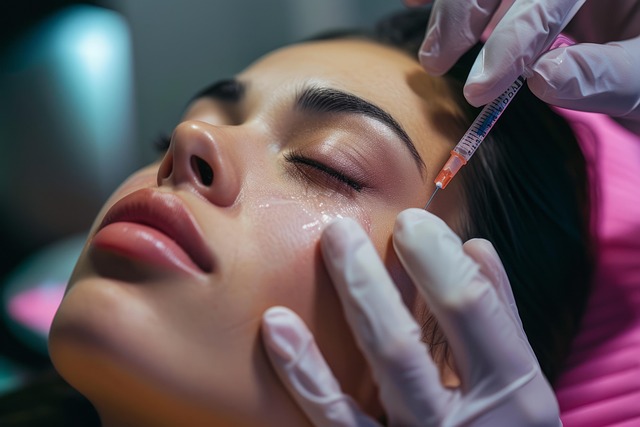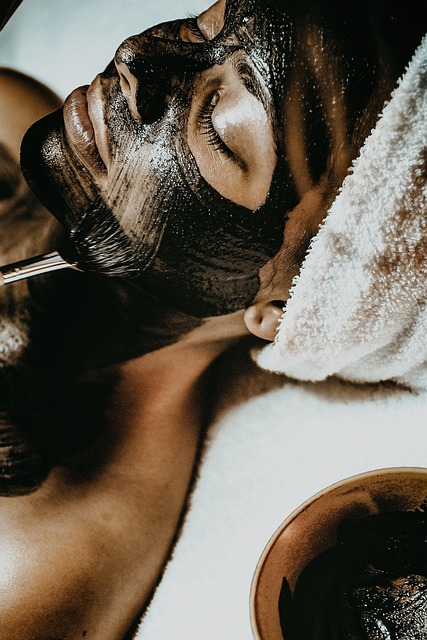Professional Botox treatments are a popular, non-surgical way to combat fine lines and wrinkles by paralyzing facial muscles with botulinum toxin. They're effective for dynamic wrinkles like frown lines and crow's feet, offering immediate and long-lasting results. Dermal fillers, primarily hyaluronic acid, enhance volume loss and plump up wrinkles immediately, lasting up to two years. Choosing between Botox and fillers depends on goals: Botox smooths dynamic lines, while fillers dramatically restore volume. Both are generally safe under professional administration but may cause temporary side effects like redness or swelling. Proper post-care after Botox treatments is crucial for optimal results, including staying hydrated and following provider recommendations.
“As we age, our skin undergoes natural changes, leading to the appearance of fine lines and volume loss. Two popular cosmetic procedures offer effective solutions: Botox for fine line reduction and dermal fillers for restoring facial volume. This comprehensive guide delves into the world of professional Botox treatments, exploring their mechanisms, benefits, and risks. We’ll compare Botox with fillers, provide insights on selection criteria, and offer post-treatment care tips to help you make an informed decision for achieving a youthful complexion.”
Understanding Fine Lines and Their Causes

Fine lines, often the first visible signs of aging, are a natural part of the skin’s aging process. They can appear on various parts of the face, such as the forehead, around the eyes (known as crow’s feet), and on the upper lip. These delicate lines form due to a combination of factors, including sun exposure, muscle movement, loss of collagen production, and genetic predisposition. Collagen, a protein that provides skin elasticity, plays a crucial role in maintaining a smooth and youthful appearance. Over time, collagen levels decrease, leading to reduced skin firmness and the formation of fine lines.
Professional Botox treatments have emerged as a popular solution for addressing these fine lines non-surgically. Botox, a type of neurotoxin, works by temporarily paralyzing facial muscles that contribute to line formation. By reducing muscle activity, it prevents the repeated contractions that can deepen wrinkles over time. This minimally invasive procedure offers a safe and effective way to smooth out fine lines, providing a more relaxed and rejuvenated look.
The Role of Botox in Treating Fine Lines

Professional Botox treatments have emerged as a popular and effective solution for addressing fine lines and wrinkles, offering a non-invasive approach to skincare. By injecting a small amount of botulinum toxin into specific areas, trained professionals can temporarily paralyze or relax the muscles responsible for creasing the skin. This action prevents the contraction of these muscles, thereby reducing the appearance of lines and wrinkles over time.
Botox is particularly effective for targeting expression lines, such as frown lines between the eyebrows, crow’s feet around the eyes, and forehead wrinkles. It provides a smooth, rejuvenated complexion by smoothing out the skin’s surface, offering both immediate and long-lasting results. Many individuals opt for regular Botox treatments to maintain their youthful appearance and prevent the progression of fine lines.
What to Expect During a Professional Botox Treatment

When considering professional Botox treatments, it’s crucial to understand what to expect from start to finish. The initial consultation with a qualified dermatologist or aesthetic specialist is key. They will assess your skin, discuss your goals, and address any concerns you may have about the procedure. During this time, they might also point out areas that could benefit most from Botox injections, focusing on fine lines and wrinkles around the eyes, forehead, and mouth.
On the day of the treatment, you’ll be given local anaesthetic to numb the targeted areas, ensuring a comfortable experience. A fine needle is then used to inject small amounts of Botox into specific muscles. The process is quick, usually taking less than 30 minutes, depending on the area being treated and the number of injections required. After the treatment, mild redness or swelling may occur, but these symptoms typically subside within a few hours. It’s essential to follow post-treatment instructions carefully for optimal results.
Fillers: A Solution for Volume Loss

Fillers, a popular choice among many, offer a solution for volume loss associated with aging. These substances, typically composed of hyaluronic acid, are injected into the skin to replace lost moisture and enhance facial contours. They provide immediate results, plumping up wrinkles and enhancing areas that have lost definition over time.
Unlike Botox, which primarily targets muscle activity, fillers focus on adding substance back into the skin. This makes them a go-to option for patients seeking a more substantial, long-lasting lift. Professional Botox treatments often include filler administration as part of a comprehensive anti-aging strategy, addressing both dynamic lines and volume loss effectively.
Types of Dermal Fillers and Their Uses

In the world of aesthetic treatments, both Botox and dermal fillers play pivotal roles in addressing different signs of aging. Dermal fillers, a game-changer in the skincare industry, offer a range of options for patients seeking volume restoration and contour enhancement. These include hyaluronic acid fillers, collagen stimulators, and poly-L-lactic acid (PLLA) fillers, each with unique properties catering to various needs. Hyaluronic acid fillers, popular choices for professional Botox treatments, are known for their immediate plumping effect and ability to last up to 6-12 months. Collagen stimulators, on the other hand, initiate a natural metabolic response, encouraging the body to produce more collagen over time, resulting in sustained volume. PLLA fillers provide longer-lasting results, ideal for individuals seeking long-term solutions.
When considering Botox or dermal fillers, it’s crucial to consult with a qualified professional who can assess your specific concerns and goals. For fine lines, Botox injections relax muscle activity, preventing dynamic wrinkles from forming. In contrast, dermal fillers are indicated for more pronounced volume loss, enhancing facial contours and restoring a youthful appearance. Understanding these distinctions allows patients to make informed decisions, ensuring they receive the most suitable treatment for their needs.
Comparing Botox and Fillers: Benefits and Considerations

When considering non-invasive cosmetic procedures, understanding the differences between Botox and fillers is essential for making an informed decision. Both are popular choices for addressing signs of aging, but they work in distinct ways. Botox, a neurotoxin, smooths fine lines and wrinkles by temporarily paralyzing facial muscles responsible for creasing the skin. It’s particularly effective for dynamic wrinkles, those that form when you frown or smile. On the other hand, fillers enhance facial volume by injecting hyaluronic acid or collagen into specific areas to lift and sculpt. Fillers are ideal for patients looking to regain lost volume in the cheeks, jawline, or lips, providing immediate results that can last up to two years.
Choosing between Botox and fillers depends on individual goals and skin type. Professional Botox treatments are highly effective for subtle, targeted corrections, making them a go-to for preventing and minimizing existing fine lines. Fillers, while offering dramatic volume enhancement, may not be suitable for those with very thin or sensitive skin, as they can cause temporary redness or swelling. It’s crucial to consult a qualified professional who can assess your unique needs and recommend the most beneficial treatment option.
Choosing the Right Treatment: Factors to Consider

When deciding between Botox for fine lines and fillers for volume, several factors come into play. It’s crucial to consult a professional who can assess your specific needs and skin type. Both Botox and fillers have their unique benefits and applications; understanding these differences is essential for making an informed decision.
For instance, Botox is ideal for targeting dynamic wrinkles caused by facial expressions, providing a more relaxed and youthful appearance. On the other hand, fillers are best suited for restoring volume loss in areas like the cheeks and jawline, enhancing facial contours. Considering your desired outcome, budget, and potential side effects will guide you towards the right treatment choice—whether it’s professional Botox treatments or filler injections.
Safety and Side Effects: Addressing Common Concerns

When considering either Botox or fillers for fine lines and volume, safety is a top concern. It’s important to remember that both procedures are generally safe when administered by a qualified professional. However, as with any medical treatment, there are potential side effects. For Botox, these may include temporary bruising, swelling, or discomfort at the injection site, headaches, and muscle weakness in rare cases. Fillers can cause redness, swelling, or pain at the injection area, but more severe reactions are uncommon.
Choosing between professional Botox treatments and fillers often depends on individual needs. Botox is particularly effective for preventing and reducing the appearance of dynamic lines caused by facial expressions. Fillers, on the other hand, offer a quick way to restore volume loss and enhance certain features. Consulting with a dermatologist or an experienced aesthetic provider can help you make an informed decision based on your specific goals and medical history, ensuring the safest and most effective treatment.
Post-Treatment Care and Maintenance

After receiving Professional Botox Treatments, proper post-care is essential for optimal results and to minimize any potential side effects. Patients should follow their dermatologist or healthcare provider’s recommendations, which may include avoiding strenuous activities, direct sun exposure, and certain medications for a specified period after the procedure. Staying hydrated, using gentle skincare products, and applying cold compresses can aid in reducing swelling and discomfort.
Regular maintenance is crucial to sustaining the results of Botox or filler injections. Depending on the individual’s goals and the product used, follow-up treatments every 3-6 months may be necessary. Consistent care ensures that the effects remain consistent, and any new lines or volume loss are addressed promptly. Consulting with a professional will help determine the ideal maintenance schedule tailored to one’s specific needs.
